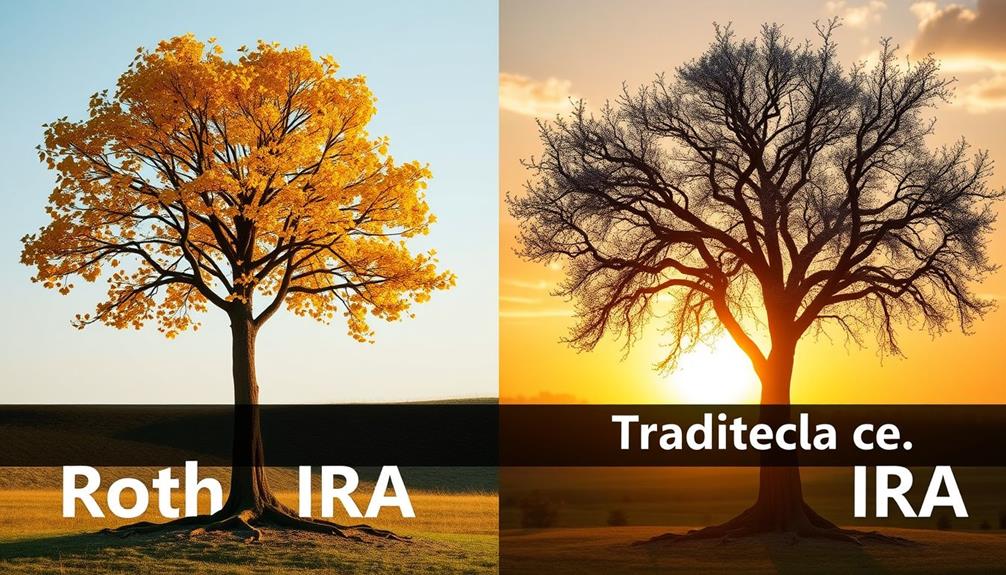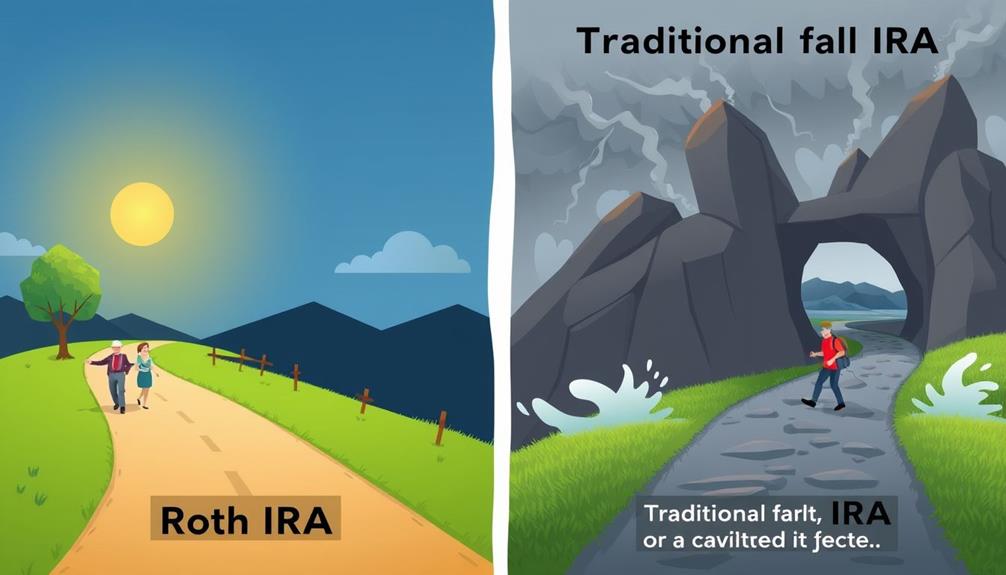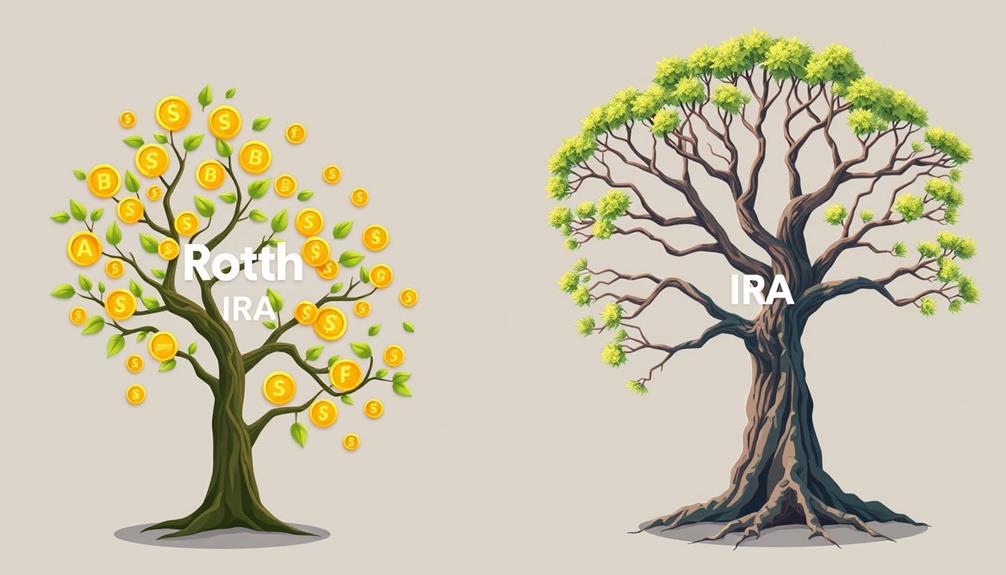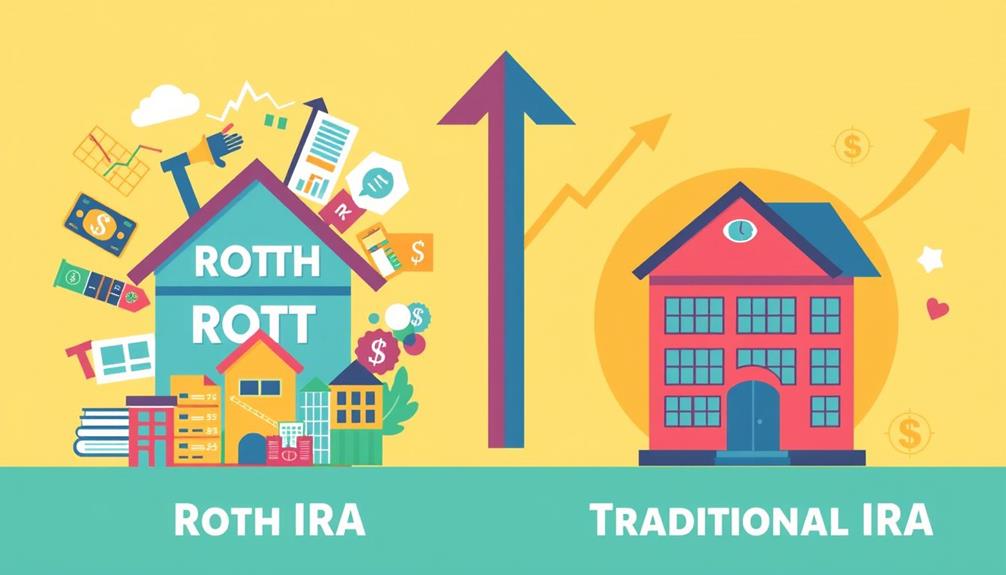Choosing between a Roth and a Traditional IRA affects your retirement wealth growth based on your current income and future tax situation. A Roth IRA allows tax-free withdrawals in retirement, beneficial if you expect to be in a higher tax bracket later. On the other hand, a Traditional IRA offers immediate tax deductions, which can help you save more now, but you'll pay taxes on withdrawals. Consider factors like RMDs and early withdrawal penalties, as these can influence your decision. There's plenty more to explore on how each option fits into your retirement plan.
Key Takeaways
- Roth IRAs offer tax-free withdrawals in retirement, making them advantageous for long-term growth if tax rates increase.
- Traditional IRAs provide immediate tax deductions, potentially increasing your investment capital now, but future withdrawals are taxed.
- Roth IRAs have no required minimum distributions (RMDs), allowing your investments to grow tax-free for as long as you wish.
- If you expect to be in a higher tax bracket in retirement, Roth IRAs may grow your wealth faster due to tax-free withdrawals.
- Consider your current and anticipated future tax situation to determine which IRA type maximizes your retirement wealth growth.
Overview of Roth and Traditional IRAs

When you're planning for retirement, understanding the differences between a Roth IRA and a Traditional IRA can greatly impact your savings strategy. A Roth IRA allows you to make contributions with after-tax dollars, which means you can enjoy tax-free withdrawals in retirement.
On the other hand, a Traditional IRA offers tax-deductible contributions, but you'll owe taxes on withdrawals when you retire.
For 2024, both types have a contribution limit of $7,000, or $8,000 if you're aged 50 or over. One significant distinction is that Roth IRAs don't have required minimum distributions (RMDs) during your lifetime, while Traditional IRAs require RMDs to start at age 73.
Additionally, Roth IRAs come with income eligibility restrictions; for instance, single filers can only contribute fully if their modified adjusted gross income (MAGI) is below $161,000.
Both IRAs provide a variety of investment options, including stocks, bonds, and mutual funds, allowing you to tailor your retirement savings to your financial goals. Understanding these key features can help you make a more informed choice for your retirement planning.
Key Differences and Tax Implications

Understanding the key differences between Roth and Traditional IRAs can greatly influence your retirement savings strategy. When evaluating Roth IRA vs. Traditional IRA, the tax implications of your contributions and withdrawals are vital.
Traditional IRAs allow tax-deductible contributions, reducing your taxable income for the year, whereas Roth IRAs require after-tax contributions, offering no immediate tax benefit. Additionally, it's important to reflect on your long-term investment strategy and common financial terms and jargon that might affect your decision-making process.
For 2024, both account types have a contribution limit of $7,000 ($8,000 for those aged 50 and over), but keep in mind the income limits for Roth IRAs. Contributions phase out for single filers with a Modified Adjusted Gross Income (MAGI) above $161,000.
Withdrawals from Traditional IRAs are taxed as ordinary income, while qualified withdrawals from Roth IRAs provide tax-free growth, including both contributions and earnings.
Additionally, Traditional IRAs require Required Minimum Distributions (RMDs) starting at age 73, while Roth IRAs don't impose RMDs during your lifetime. This allows your investments to grow uninterrupted.
If you need to access funds early, Traditional IRAs incur a 10% penalty plus taxes, whereas Roth IRA contributions can be withdrawn anytime tax-free, though earnings may face penalties.
Withdrawal Rules and Penalties

Knowing the withdrawal rules and penalties is key to managing your retirement funds effectively. With a Traditional IRA, you're required to start taking Required Minimum Distributions (RMDs) at age 73, which can limit your growth potential.
If you make early withdrawals before age 59½, you'll face a 10% penalty plus income tax on those amounts. In contrast, a Roth IRA offers greater flexibility. You can withdraw your contributions at any time, tax-free, without penalties.
However, if you withdraw earnings early, you might incur penalties unless you're 59½ and the account has been open for at least five years. After that, your earnings can be withdrawn tax-free.
Both account types allow for penalty-free withdrawals under special circumstances, like first-time home purchases or educational expenses, but the rules differ considerably.
In essence, Traditional IRAs come with strict withdrawal rules that could lead to penalties, while Roth IRAs provide more access to your contributions without fees, allowing your retirement wealth to grow more freely.
Understanding these distinctions will help you choose the right path for your financial future.
When to Consider Each IRA Type

Deciding between a Roth and a Traditional IRA often hinges on your current financial situation and future expectations. If you're a younger investor expecting to be in a higher tax bracket during retirement, a Roth IRA could be your best bet. With contributions made using after-tax dollars, you'll enjoy tax-free growth and withdrawals later on.
On the other hand, if you're looking for immediate tax deductions, a Traditional IRA may align better with your goals, especially if you anticipate a lower tax rate in retirement. Understanding the key differences can guide your financial planning.
| Aspect | Roth IRAs | Traditional IRAs |
|---|---|---|
| Contributions | Made with after-tax dollars | Potential tax deductions available |
| Early Withdrawals | No penalties on contributions | Penalties for early withdrawals apply |
| Required Minimum Distributions | No RMDs during account owner's lifetime | RMDs required starting at age 72 |
Consider your need for access to funds, potential earnings growth, and estate planning goals when choosing between these two IRA types. Each offers unique tax benefits that can enhance your retirement wealth.
Rollover and Inherited IRAs

Rollover and Inherited IRAs frequently come into play when individuals shift between jobs or experience the loss of a loved one. Rollover IRAs allow you to transfer funds from employer-sponsored plans, like 401(k)s, without incurring tax penalties, preserving the tax-advantaged status of your funds.
Contributions to a rollover IRA are typically made with pre-tax money, allowing your account to grow tax-deferred until you withdraw funds in retirement.
When it comes to inherited IRAs, beneficiaries must establish these accounts after the original holder's death. If you're a spouse, you can treat the inherited IRA as your own, enabling continued contributions and tax-free growth.
However, non-spouse beneficiaries have different rules to follow, including the requirement for required minimum distributions (RMDs). Missing RMDs can result in hefty penalties, usually 50% of the amount that should've been distributed but wasn't.
Understanding the nuances of rollover and inherited IRAs is essential for effective retirement planning, ensuring you maximize your wealth potential while avoiding unnecessary penalties.
Investment Flexibility

When managing your retirement savings, investment flexibility in IRAs plays a significant role in tailoring your financial strategy. Both Traditional and Roth IRAs offer a variety of investment options, allowing you to align your portfolio with your risk tolerance and financial goals.
Here's how you can maximize that flexibility:
- Choose from diverse investment options like stocks, bonds, mutual funds, and ETFs.
- Opt for active portfolio management or passive strategies, such as index funds, to suit your expertise level.
- Take advantage of Traditional IRAs for tax-deferred growth, deferring taxes until withdrawal, or select Roth IRAs for tax-free growth on qualified distributions.
- Compare account fees and investment costs across providers to minimize expenses and enhance your returns.
Additionally, both IRA types may include robo-advisors, offering automated investment management at a lower cost. This can be especially appealing if you're a younger investor seeking efficient portfolio management without the burden of high fees.
Choosing the Right IRA

Choosing the right IRA can feel overwhelming, but understanding your financial situation can simplify the process. Start by evaluating your current tax bracket and how it might change by the time you retire. If you expect to be in a higher bracket later, a Roth IRA might serve you better due to its tax-free withdrawals.
For 2024, remember that both Roth and Traditional IRAs have a contribution limit of $7,000, with an extra $1,000 allowed for those aged 50 and over.
Keep in mind that Roth IRAs have income limits; if your modified adjusted gross income exceeds $161,000 as a single filer, your ability to contribute phases out. Traditional IRAs, however, don't have these income limits, although tax deductibility can vary.
Also, consider that Traditional IRAs require minimum distributions (RMDs) starting at age 73, while Roth IRAs allow you to enjoy tax-free growth without RMDs during your lifetime.
Ultimately, your investment horizon and retirement timeline are essential. Younger investors may favor Roth IRAs for long-term tax-free growth, while those nearing retirement often benefit from the immediate tax advantages of Traditional IRAs.
Additional Resources and Support

Accessing additional resources and support can greatly enhance your understanding of Roth and Traditional IRAs. Knowing how these accounts differ is crucial for maximizing your retirement savings.
Here are some key resources to explore:
- Financial Advisors: They can provide personalized advice, helping you navigate tax deductions and choose the right IRA based on your financial situation.
- Online Calculators: Use these tools to project your potential growth, taking into account the contribution limit of $7,000 for 2024 and how tax-free withdrawals from Roth IRAs differ from Traditional IRA benefits.
- Educational Materials: Many institutions offer brochures and guides explaining investment options and withdrawal rules, making it easier for you to grasp the nuances of each IRA type.
- Retirement Workshops: Attend local or online workshops to gain insights from experts and connect with others on similar retirement journeys.
Frequently Asked Questions
Is Roth or Traditional IRA Better for Retirees?
When considering which IRA's better for you as a retiree, think about your tax situation. If you expect to be in a higher tax bracket, a Roth IRA might serve you better than a Traditional IRA.
Is It Better to Put Money Into Roth or Traditional Ira?
Like choosing a path through a forest, deciding between a Roth or Traditional IRA depends on your future financial landscape. If you expect higher taxes, opt for Roth. If lower, consider Traditional. Trust your instincts!
Why Would Someone Choose a Roth IRA Over a Traditional Ira?
You might choose a Roth IRA for its tax-free withdrawals in retirement, flexibility with contributions, and the potential to avoid rising tax rates. Plus, it offers penalty-free access to funds for first-time home purchases.
Should My Retirement Be Roth or Traditional?
Did you know that 90% of younger investors prefer Roth IRAs? If you expect higher taxes later, consider a Roth for tax-free withdrawals. If you need immediate tax relief, a Traditional might suit you better.
Conclusion
Ultimately, choosing between a Roth and Traditional IRA is like picking between two paths in a forest. Both lead to retirement wealth, but the scenery changes based on your choices. If you expect to be in a higher tax bracket later, the Roth might be your sunshine-filled trail. But if you want immediate tax relief, the Traditional could be your shaded route. Whichever path you take, just make sure it aligns with your long-term financial goals.










